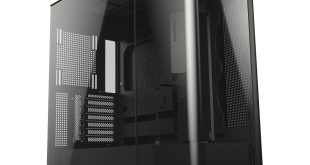After removing the two thumbscrews, the top panel of the case slides off to reveal the interior. It initially looks a little bit cramped but this is because all the drive cages sit in the top of the case.
There is room for three 3.5″ hard drives and three 2.5″ hard drives in total but you can also install three 2.5″ hard drives in the 3.5″ bays if you prefer. There is also space for a single 5.25″ optical drive which sits behind the front bezel.
These drive bays are spread between three different caddies which slot into the top of the chassis. These have to be removed before we can install anything else into the chassis.
When the drive caddies have been removed, the chassis is divided into two parts by an aluminium bar which supports the drive caddies. You can remove this if you like by taking out the screws on either end but this isn't necessary for installation.
As a space saving measure, the motherboard standoffs are fixed to the bottom panel of the case, removing the need for a dedicated motherboard tray. Unfortunately this means that it is going to be more difficult to manage the cables without causing a mess, although it is still possible.
There are four full-size add-in card slots in the rear of the chassis which have ventilated covers installed by default. These are secured by standard screws, rather than thumbscrews, which are located outside the case to give a little extra room for long graphics cards.
Unlike some more compact cases, the PC-C50 has plenty of room for a large power supply. This room would be restricted slightly however if you decide to install an exhaust fan in the left hand side of the chassis.
There is a vent in the bottom of the chassis for the power supply which doesn't have a dust filter. In fact, none of the case's fans have dust filters so be prepared to give your system a thorough clean every so often.
At the front we find an abundance of wires spewing from the front panel connections. These are all very long, making it very easy to route the cables around the chassis. As there aren't many motherboards on the market which support more than two USB3 ports, Lian Li have included an adapter which lets you attach two of the front panel USB3 ports to an internal USB2 header.
 KitGuru KitGuru.net – Tech News | Hardware News | Hardware Reviews | IOS | Mobile | Gaming | Graphics Cards
KitGuru KitGuru.net – Tech News | Hardware News | Hardware Reviews | IOS | Mobile | Gaming | Graphics Cards







